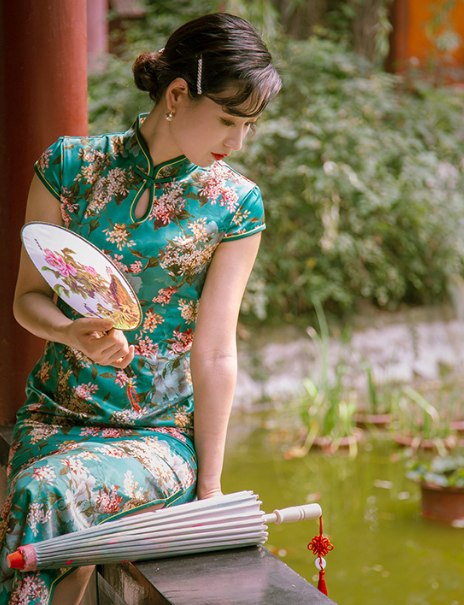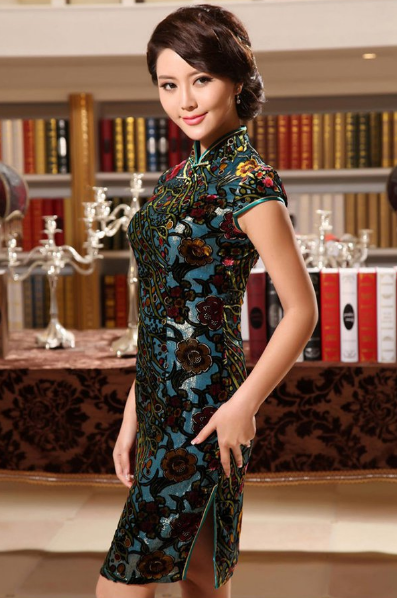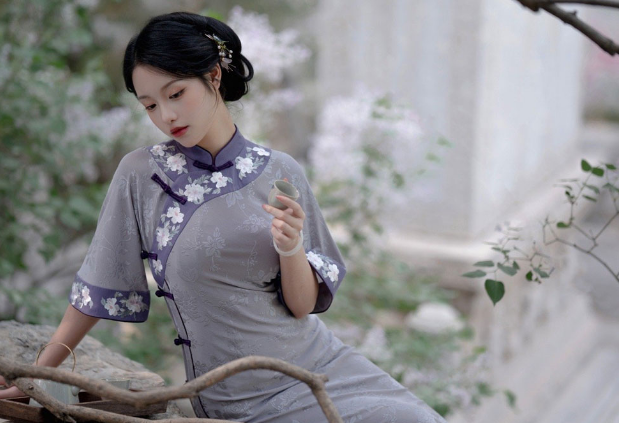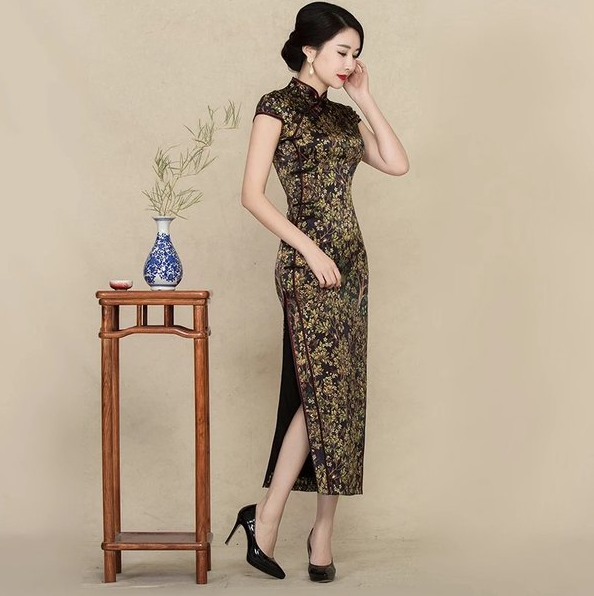Origins of the Cheongsam
The origins of the cheongsam, also known as the qipao, can be traced back to ancient China, with its earliest roots believed to date back over three centuries. This iconic Chinese garment, characterized by its elegant form-fitting silhouette, has a rich history.
Early Origins
The earliest prototypes of the cheongsam can be linked to the clothing worn by the Manchu people during the Qing Dynasty. During this period (1644-1912), Manchu fashion exerted significant influence over the attire of the Han Chinese. Manchu clothing featured a high-necked collar, straight lines, and a one-piece robe-like design. This early form of the cheongsam, however, was more modest and less tailored than the versions we recognize today.

Qing Dynasty Influence
The Qing Dynasty played a pivotal role in shaping the early development of the cheongsam. Under the Qing Dynasty’s rule, clothing regulations were established to distinguish between different social classes and ethnic groups. The Manchu-style clothing was imposed on the Han Chinese as a sign of submission.
Evolution of the Cheongsam
The cheongsam, as we know it today, began to take shape during the late Qing Dynasty and the early Republic of China era (early 20th century). It gradually evolved from a loose-fitting, one-piece dress to a more form-fitting and stylish garment.
Key Evolutionary Features
- High Neckline: The traditional high neckline of the cheongsam was retained from its Manchu origins, symbolizing modesty and grace.
- Tailoring: Innovations in tailoring techniques led to a more fitted silhouette, highlighting the female form.
- Materials: The choice of fabrics, such as silk, became more diverse, reflecting both luxury and cultural symbolism.
- Embellishments: Elaborate embroidery and button designs began to adorn the cheongsam, signifying status and taste.
This evolution marked the transition from the utilitarian clothing of the Qing Dynasty to the fashionable and iconic attire that the cheongsam represents today.
Qing Dynasty Influences
The Qing Dynasty (1644-1912) left a significant mark on Chinese fashion, influencing the early development of the cheongsam.
Fashion in the Qing Dynasty
- Manchu Clothing Dominance: During the Qing Dynasty, Manchu clothing dominated the fashion landscape. Manchu clothing featured distinctive characteristics like a straight-cut silhouette and high, closed collars.
- Social Class Differentiation: Clothing regulations were strict, with specific styles and colors reserved for different social classes. The Qing government used clothing as a means to distinguish between ethnic groups and maintain social order.
Emergence of the Cheongsam
The cheongsam started to gain popularity during the late Qing Dynasty, particularly in the late 19th century and early 20th century.
Factors Behind its Emergence
- Western Influence: China’s interactions with the Western world, including trade and cultural exchanges, introduced new ideas and fashions. The cheongsam incorporated elements of Western tailoring and design.
- Women’s Liberation: The cheongsam represented a shift towards more practical and comfortable clothing for women. It allowed greater freedom of movement compared to the traditional, cumbersome attire.
- Popularity Among Urban Elite: The cheongsam gained favor among urban elites, including the educated class and women in the upper strata of society. Its popularity was driven by a desire for modernity and a break from old traditions.
Key Characteristics of Early Cheongsam
- High Collar: The cheongsam retained the high, closed collar from Manchu clothing, symbolizing modesty.
- Buttoned Front: The use of buttons down the front of the dress became a signature feature.
- One-Piece Design: The one-piece design was retained from earlier Manchu influences, but it became more fitted over time.
The Qing Dynasty’s impact on fashion and the emergence of the cheongsam marked a dynamic period in Chinese clothing history, where tradition and modernity intersected.
Manchu clothing | Qing Dynasty | Chinese fashion
Evolution during the Republic Era
The Republic Era (1912-1949) marked a significant phase in the evolution of the cheongsam, transitioning it from traditional qipao to the modern, iconic cheongsam we know today.
Transition from Qipao to Cheongsam
High Demand for Modernity: During the early Republic Era, there was a growing demand for modern clothing that allowed for greater mobility and reflected changing societal norms.
Tailoring and Fit: The transition was marked by a shift from the looser, more traditional qipao to a more fitted and stylish design. This allowed for better showcasing of the female form.
Influence of Western Fashion: The influence of Western fashion, including streamlined silhouettes and tailored designs, played a crucial role in shaping the cheongsam’s evolution. This era saw the incorporation of elements such as a front-buttoned closure and a sleeker appearance.
Social and Cultural Factors
Women’s Liberation: The Republic Era was characterized by increased gender equality and women’s participation in society. The cheongsam became a symbol of women’s liberation, as it provided greater freedom of movement compared to traditional clothing.
Urbanization and Modernization: The rapid urbanization and modernization of China’s major cities created an environment where the cheongsam could flourish. It was adopted by urban elites and became a popular choice for women in urban centers.
Symbolism and Identity: The cheongsam, with its blend of traditional Chinese elements and modern aesthetics, became a symbol of China’s efforts to modernize while preserving its cultural heritage. It represented a balance between tradition and progress.
Materials and Quality: The cheongsam’s popularity led to innovations in materials and craftsmanship. High-quality silk and embroidery became defining features of this garment.
By the end of the Republic Era, the cheongsam had evolved into a symbol of modernity and elegance, reflecting the changing social, cultural, and fashion landscape of China.
Republic Era | Qipao | Western fashion influence | Chinese modernization

Contemporary Cheongsam Trends
The cheongsam has continued to evolve and adapt to changing fashion tastes, reflecting contemporary design trends and innovations.
Mid-20th Century Revival
Post-Revolution Rebirth: In the mid-20th century, after a period of decline during the Chinese Communist Revolution, there was a resurgence of interest in cheongsam fashion.
Reintroduction in the 1950s: During the 1950s, the Chinese government encouraged the revival of traditional clothing, including the cheongsam, as part of a broader effort to reconnect with China’s cultural heritage.
Symbol of National Pride: The cheongsam was promoted as a symbol of Chinese identity and national pride, leading to its popularity among Chinese women in the post-revolution era.
International Recognition: This period also saw the cheongsam gaining international recognition, with celebrities and fashion icons donning this elegant attire at events and red-carpet appearances.
Modern Design Innovations
Incorporation of Contemporary Elements: Contemporary cheongsam designers have embraced modern design elements while preserving the essence of this traditional attire.
Variations in Silhouette: Designers have introduced variations in silhouette, including A-line and mermaid styles, providing options to suit different body types and preferences.
Fusion with Western Fashion: The integration of Western fashion elements such as lace, sequins, and innovative fabrics has brought a fresh and trendy dimension to the cheongsam.
Customization and Personalization: With advancements in technology and digital design, individuals can now customize their cheongsam designs, selecting materials, colors, and embellishments that suit their preferences.
Global Runway Impact: Fashion shows and collections globally feature the contemporary cheongsam, drawing a diverse, global audience.
Today’s cheongsam reflects a harmonious blend of tradition and modernity, showcasing the adaptability and enduring appeal of this iconic Chinese attire.
Chinese Communist Revolution | Cheongsam Revival | Modern Cheongsam Design | Fashion Trends | Fashion Design
Global Spread of Cheongsam
The cheongsam, once a symbol of traditional Chinese attire, has transcended its origins and gained popularity worldwide. Its global spread has been influenced by various factors.
The Cheongsam Beyond China
Early International Appearances: The cheongsam first gained international recognition in the early 20th century when it appeared in international fashion magazines and on the silver screen.
Hollywood Influence: In the 1920s and 1930s, Hollywood actresses such as Anna May Wong and Marlene Dietrich popularized the cheongsam in the West. It became a symbol of exoticism and glamour.
Fashion Revivals: Throughout the 20th century, there were several cheongsam fashion revivals in Western countries, driven by nostalgia and a fascination with Chinese culture.
Global Celebrities: Contemporary celebrities like Rihanna, Nicole Kidman, and Michelle Yeoh have worn the cheongsam at major events, introducing it to a new generation of fashion enthusiasts.
Cultural Appropriation or Appreciation
Global Reception: The global reception of the cheongsam has been diverse. While some view it as a form of cultural appreciation and celebration, others have criticized its use as cultural appropriation.
Cultural Sensitivity: Discussions emphasize respectful wear, cultural significance, and origin acknowledgment when donning the cheongsam.
Cultural Exchange: The global cheongsam spread fosters cross-cultural exchange and deeper understanding of Chinese culture.
Commercialization Debate: Ongoing debates surround cheongsam commercialization’s impact on traditional craftsmanship and authenticity.
In recent years, the cheongsam symbolizes not just Chinese culture but also cross-cultural dialogue on sensitivity and appreciation.
Anna May Wong | Marlene Dietrich | Rihanna | Cultural Appropriation | Cultural Sensitivity | Cultural Exchange
Cultural Significance and Beginnings
The cheongsam, with its rich history, holds significant cultural and symbolic importance within Chinese society and beyond.
Symbolism in the Cheongsam
Historical Symbolism: Historically, the cheongsam symbolized modesty and propriety in Chinese society. Its high neckline and form-fitting silhouette reflected traditional Chinese values of restraint and elegance.

Feminine Empowerment: Over time, the cheongsam also became a symbol of female empowerment. Its comfortable yet stylish design allowed women greater mobility and a sense of liberation.
Cheongsam Celebrations: Worn at weddings and special events, it symbolizes good fortune and cultural heritage.
Regional Variations: Different regions in China have their own variations of the cheongsam, each with its unique symbolism. For example, the “qun kwa” worn by brides in southern China carries specific cultural meanings.
Integration into World Culture
Hollywood Influence: The cheongsam gained global recognition through Hollywood films in the 20th century.
Chinese Diaspora: Chinese communities worldwide embrace the cheongsam as a cultural symbol, often wearing it at festivals.
Global Runway Presence: The cheongsam’s appearances on international fashion runways solidify its status as a symbol of Chinese culture.
Cultural Diplomacy: The cheongsam serves as a tool for cultural diplomacy, fostering goodwill between China and other nations.
Cultural Emblem: Today, the cheongsam bridges tradition and modernity, connecting people worldwide with Chinese culture’s beauty and significance.
Chinese culture | Cultural symbolism | Qun kwa | Cultural diplomacy








